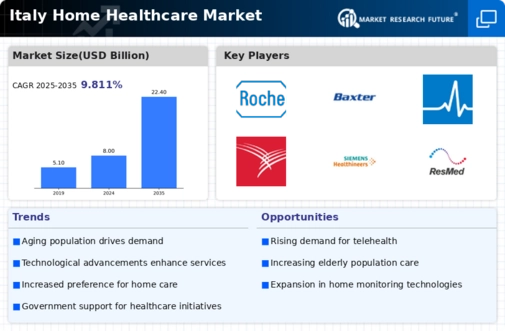Rising Healthcare Costs
The escalating costs of healthcare in Italy are driving the growth of the home healthcare market. With healthcare expenditures projected to reach €200 billion by 2025, there is a pressing need for cost-effective alternatives to hospital care. Home healthcare services offer a viable solution, as they are generally less expensive than inpatient care. This economic pressure is prompting both patients and healthcare systems to seek out home-based solutions, which can provide high-quality care at a fraction of the cost. As a result, the home healthcare market is likely to see increased investment and development of services that cater to budget-conscious consumers while maintaining quality standards.
Aging Population Dynamics
The demographic shift towards an aging population in Italy is a pivotal driver for the home healthcare market. As the proportion of individuals aged 65 and older continues to rise, the demand for home healthcare services is expected to increase significantly. In 2025, approximately 23% of the Italian population is projected to be over 65 years old, necessitating tailored healthcare solutions. This demographic trend indicates a growing need for services such as in-home nursing, rehabilitation, and assistance with daily living activities. Consequently, the home healthcare market is likely to expand to accommodate the unique needs of this aging demographic, fostering innovations in service delivery and care models.
Supportive Regulatory Environment
The regulatory framework in Italy is increasingly supportive of home healthcare services, which is a key driver for the market. Recent policy initiatives aim to promote home-based care as a viable alternative to institutional settings. The government is investing in programs that facilitate access to home healthcare services, including financial incentives for providers and patients. This supportive environment is likely to encourage the growth of the home healthcare market, as it fosters innovation and enhances service delivery. As regulations evolve, they may further streamline processes, making it easier for patients to receive care in the comfort of their homes.
Increased Focus on Preventive Care
There is a growing emphasis on preventive care within the Italian healthcare system, which is influencing the home healthcare market. As healthcare policies shift towards prevention rather than treatment, home healthcare services are becoming integral in managing chronic diseases and promoting wellness. Programs aimed at early intervention and health education are being implemented, with the goal of reducing hospital admissions and improving quality of life. This trend suggests that the home healthcare market will expand its offerings to include preventive services, thereby aligning with national health objectives and enhancing patient engagement in their own care.
Technological Advancements in Care
Technological innovations are transforming the landscape of the home healthcare market in Italy. The integration of telehealth services, remote monitoring devices, and mobile health applications is enhancing patient care and accessibility. In 2025, it is estimated that around 30% of healthcare services will be delivered through telehealth platforms, reflecting a shift towards more efficient care models. These advancements not only improve patient outcomes but also reduce costs associated with traditional healthcare delivery. The home healthcare market is thus experiencing a paradigm shift, where technology plays a crucial role in facilitating communication between patients and healthcare providers, ultimately leading to better management of chronic conditions.


















Leave a Comment